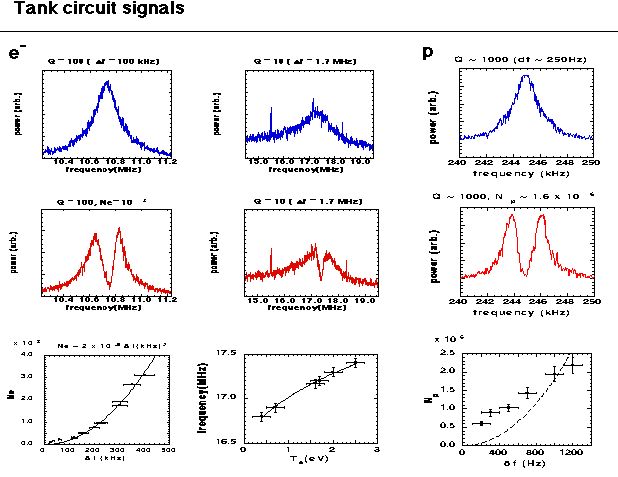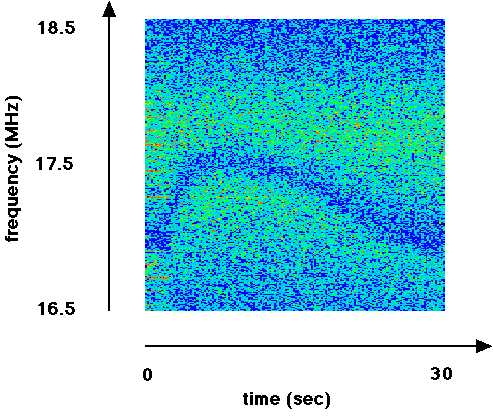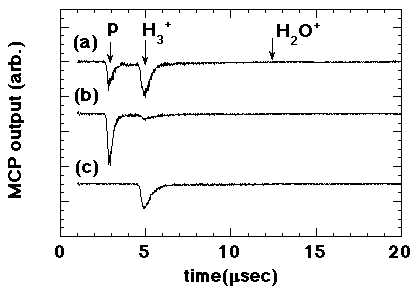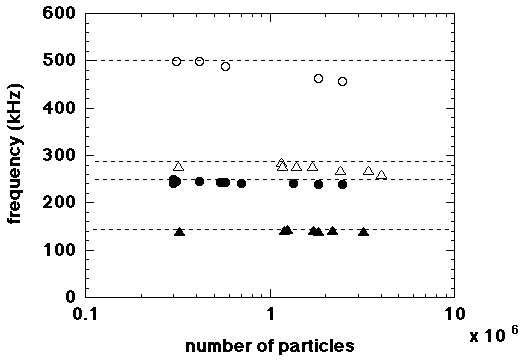Experiments with ASACUSA trap
Tank circuit signals for electrons and protons
For understanding the electron cooling process in the ASACUSA trap, it is important to observe signals from the trapped charged particles during the process. Fortunately, various techniques developed for a small number of charged particles in a Penning trap are also applicable to a large number of charged particles (a plasma) in ASACUSA trap. Especially, a tank circuit can be a very powerful tool for a nondestructive diagnosis of trapped charged particles.

FFT power spectrum during the electron cooling of high energy protons
Shown below is the observed frequency f2 as a function of time. Since the frequency shift of f2 is calibrated against the electron plasma temperature Ee, the temperature can be monitored while high energy protons are cooled with electrons in the trap. The initial frequency f2 ~ 16.8 MHz, which corresponds to the electron plasma temperature of ~ 0.3 eV, goes up abruptly right after the injection of high energy protons (2keV in this case), and reaches the maximum ~ 17.4 MHz within several seconds, which is about 2.5 eV in the electron temperature. Then, it falls off gradually with the time scale longer than the synchrotron radiation cooling time ~ 6 sec. It is found that a simple model can explain the qualitative behavior of both electron and proton energy when the initial energy of protons is less than 2keV.

Compression of protons inside the ASACUSA trap
When electrons are injected to produce protons by ionizing molecular hydrogen, not only protons but also H2^+ ions are created. The dominant process of H2^+ with the energy of 10 ~ 50 eV is the charge transfer to form slow H2^+. Here, the maximum energy of 50 eV is determined by the potential depth of the trap. Also the dominant process of H2^+ with the energy less than 10 eV is H3^+ formation. On the other hand, the dominant process of protons with the energy less than 50 eV is the momentum transfer to lose energy. Therefore, it is expected that protons and H3^+ ions are the main species after thermalization, as shown in (a). To prepare a cloud of protons, the axial RF drive at 140 kHz (fz for H3^+ ions with V=50 V) have to be applied to kick out H3^+ ions. An example of a TOF signal is shown in (b). If the axial RF drive at 250 kHz (fz for protons with V=50 V) is applied, protons are kicked out and H3^+ remains inside the trap (c). Here, 2 x 10^6 ions are confined with the confinement time longer than 600 sec. In fact, heavy positive ions were negligible compared with protons and H3^+ ions in a series of experiments.

The radial compression of trapped protons is important for the better focusing of the extracted low energy beam in a field free region. Since the magnetron frequency fm ~ fz^2 / 2fc is about 2 kHz with the cyclotron frequency fc ~ 15 MHz, the frequency fs=fz+fm for the sideband cooling of proton is about 252 kHz theoretically and fs is independent of the proton number Np when the image charge effect is negligible. By detecting the images of extracted protons on the phosphor screen with various applied frequency, it was confirmed experimentally that fs was about 250 kHz and was almost constant for 3 x 10^5 < Np < 2.5 x 10^6.

References
H.Higaki, N.Kuroda, T.Ichioka, K.Yoshiki Franzen, Z.Wang, K.Komaki, Y.Yamazaki, M.Hori, N.Oshima, and A.Mohri, Phys. Rev. E 65 046410 (2002)
H. Higaki, N. Kuroda, T. Ichioka, K. Yoshiki Franzen, Z. Wang, M. Hori, A. Mohri, K. Komaki, and Y. Yamazaki, Proceedings XXII ICPEAC, p.685 , Edited by S.Datz, M.E.Bannister, H.F.Krause, L.H.Saddiq, D.Schultz and C.R.Vane, Santa Fe, New Mexico, USA, 18-24 July 2001
N. Kuroda, H. Higaki, T. Ichioka, K. Yoshiki Franzen, Z. Wang, S. Yoneda, A. Mohri, K. Komaki, and Y. Yamazaki, Proceedings XXII ICPEAC, p.593, Edited by S.Datz, M.E.Bannister, H.F.Krause, L.H.Saddiq, D.Schultz and C.R.Vane, Santa Fe, New Mexico, USA, 18-24 July 2001
Back to the top